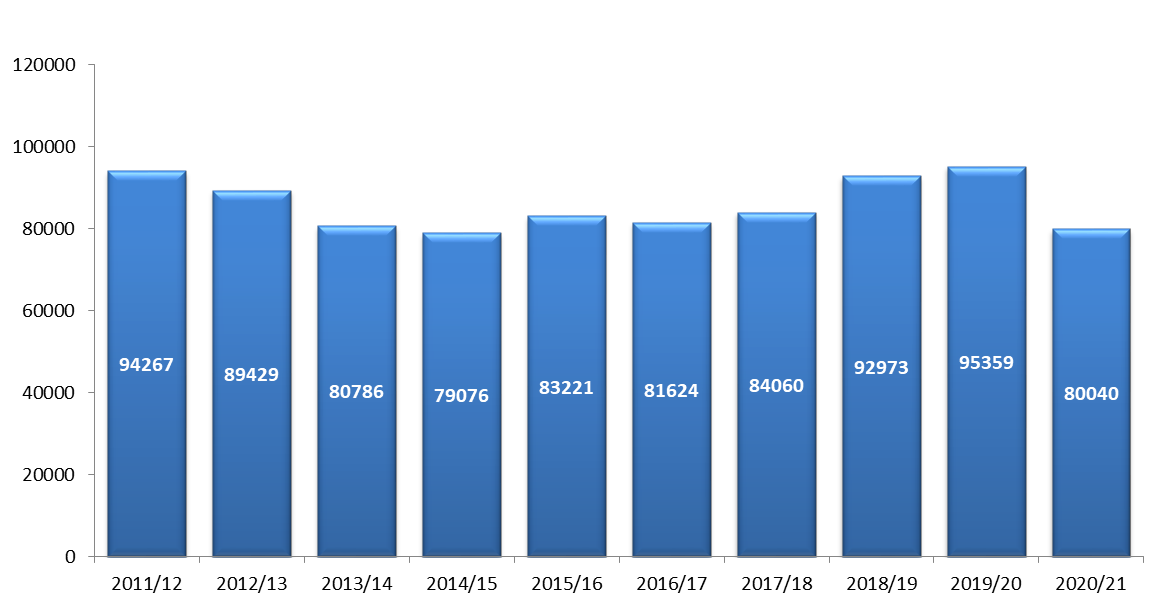Annual report 2020-21 - Agency's performance
Performance at a glance
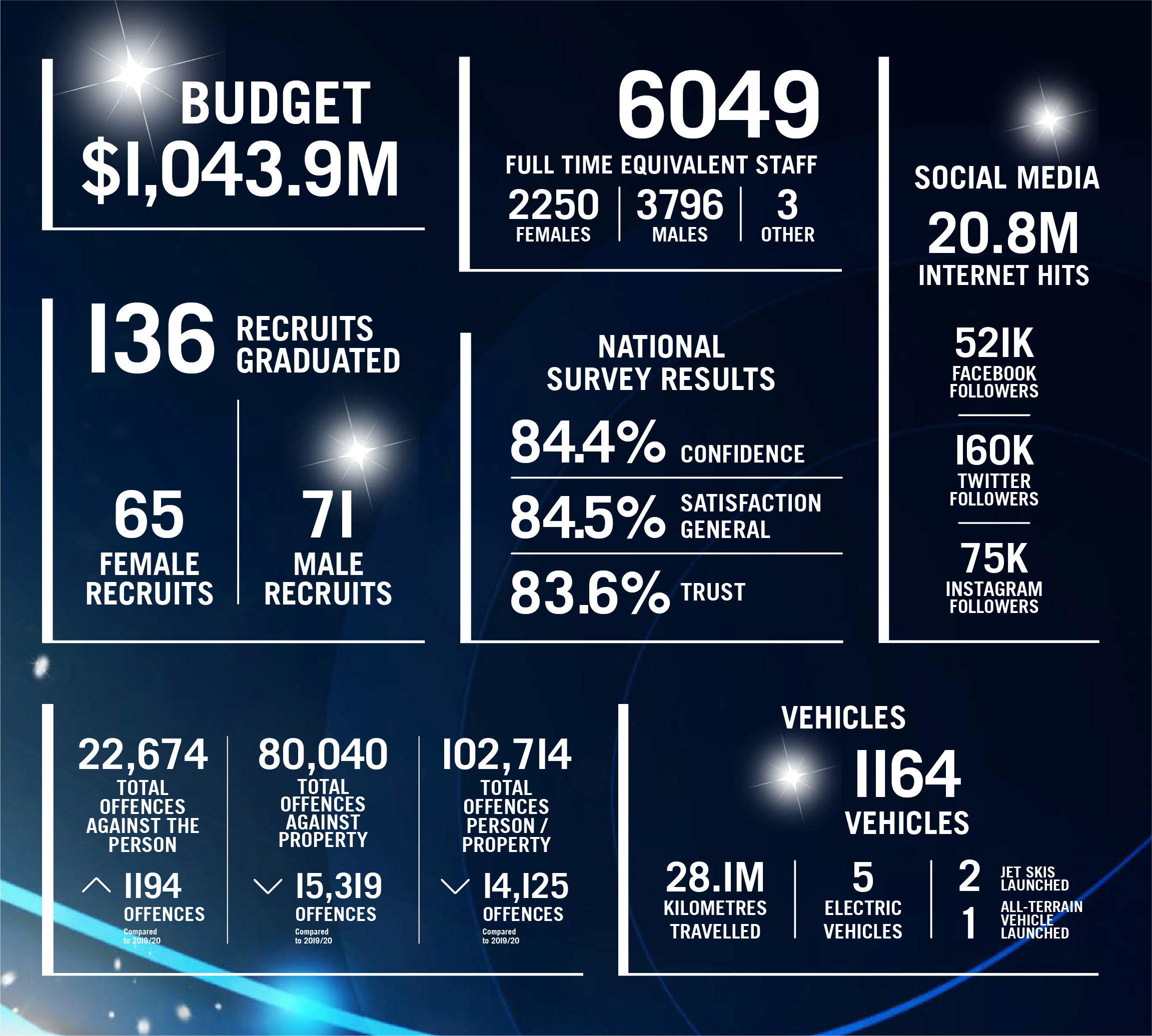
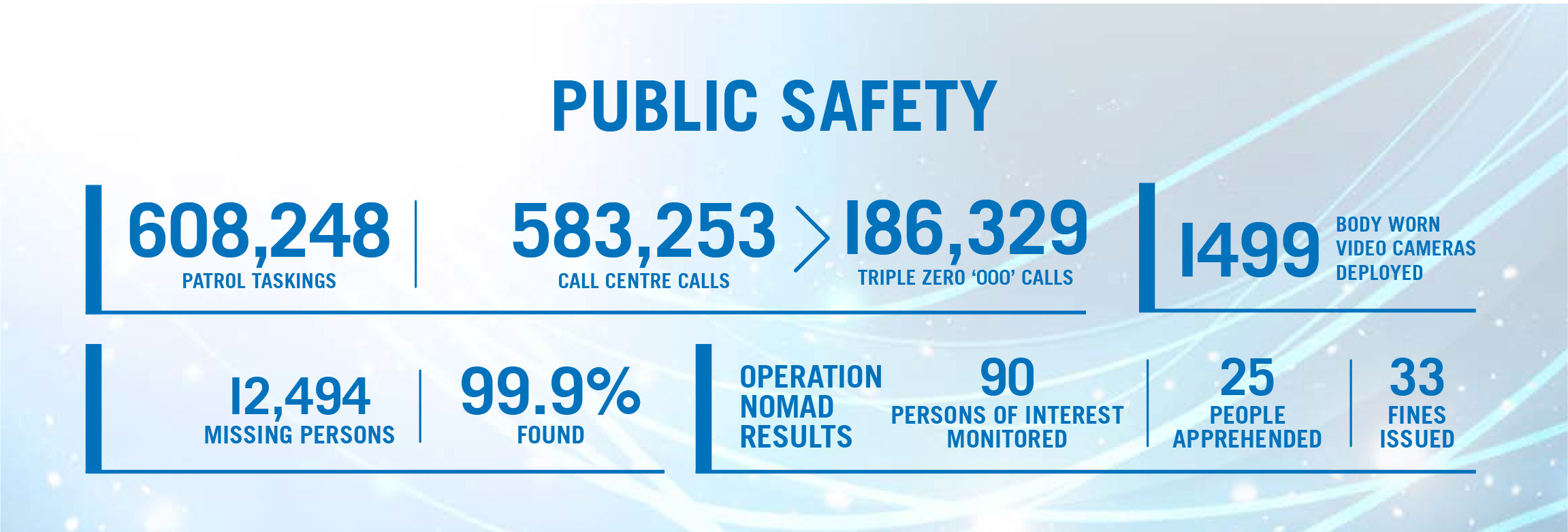
![]()

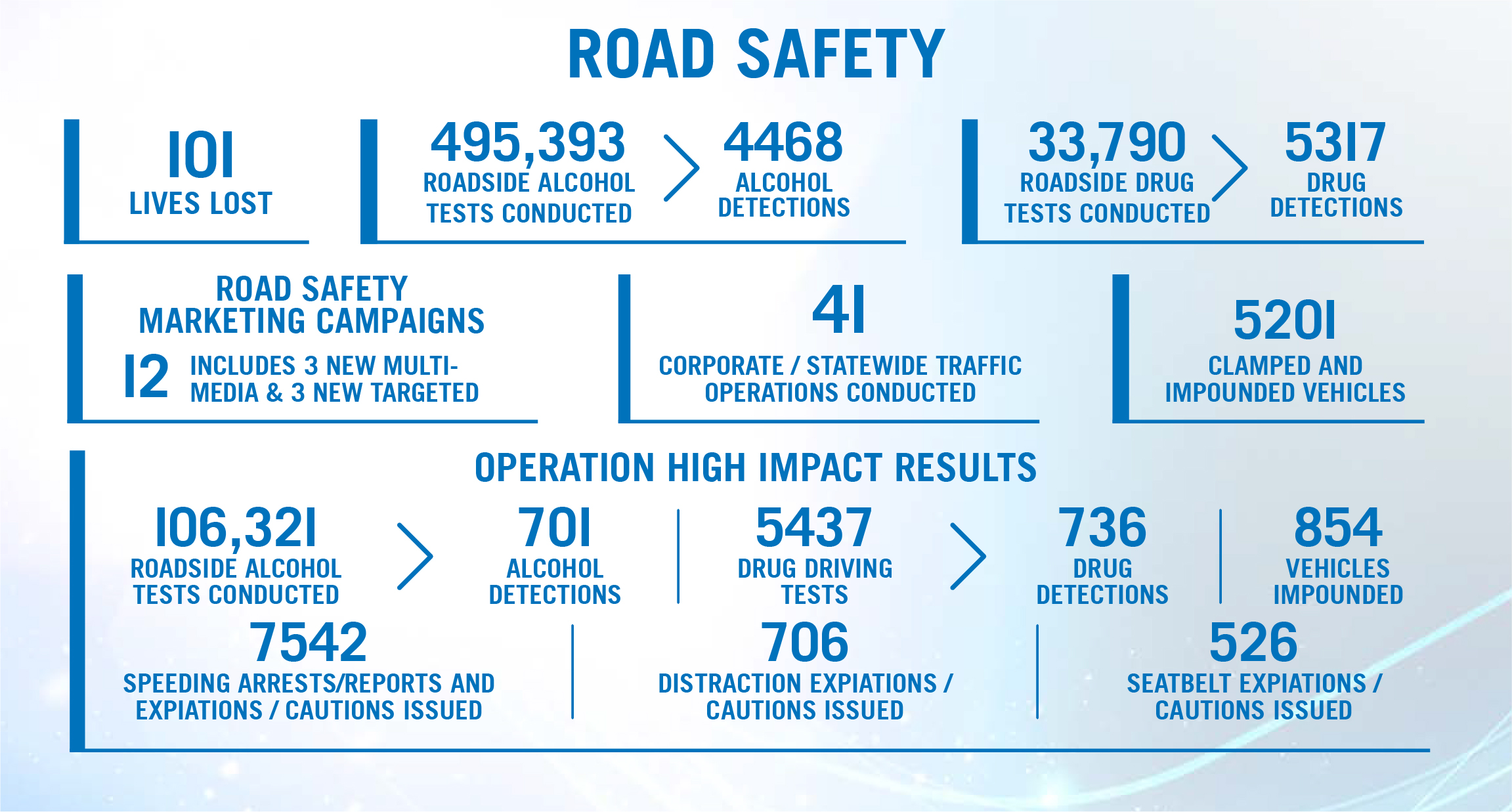
Agency response to COVID-19
In 2020-21 under the Emergency Management Act 2004 (EM), Commissioner Stevens continued as State Coordinator, working closely with the Chief Executive of Health and Wellbeing and the Chief Public Health Officer and the Premier, providing advice to government, the public, and dedicating police resources to managing the demand created by COVID-19 and the normal demands of policing.
The policing response has many dimensions. It covers issuing enforceable general directions to all persons in South Australia on issues such as isolation and quarantine requirements, border controls, and restrictions to public activities and gatherings. Directions are made in consultation with Department for Health and Wellbeing and are regularly reviewed and amended to reflect changing conditions.
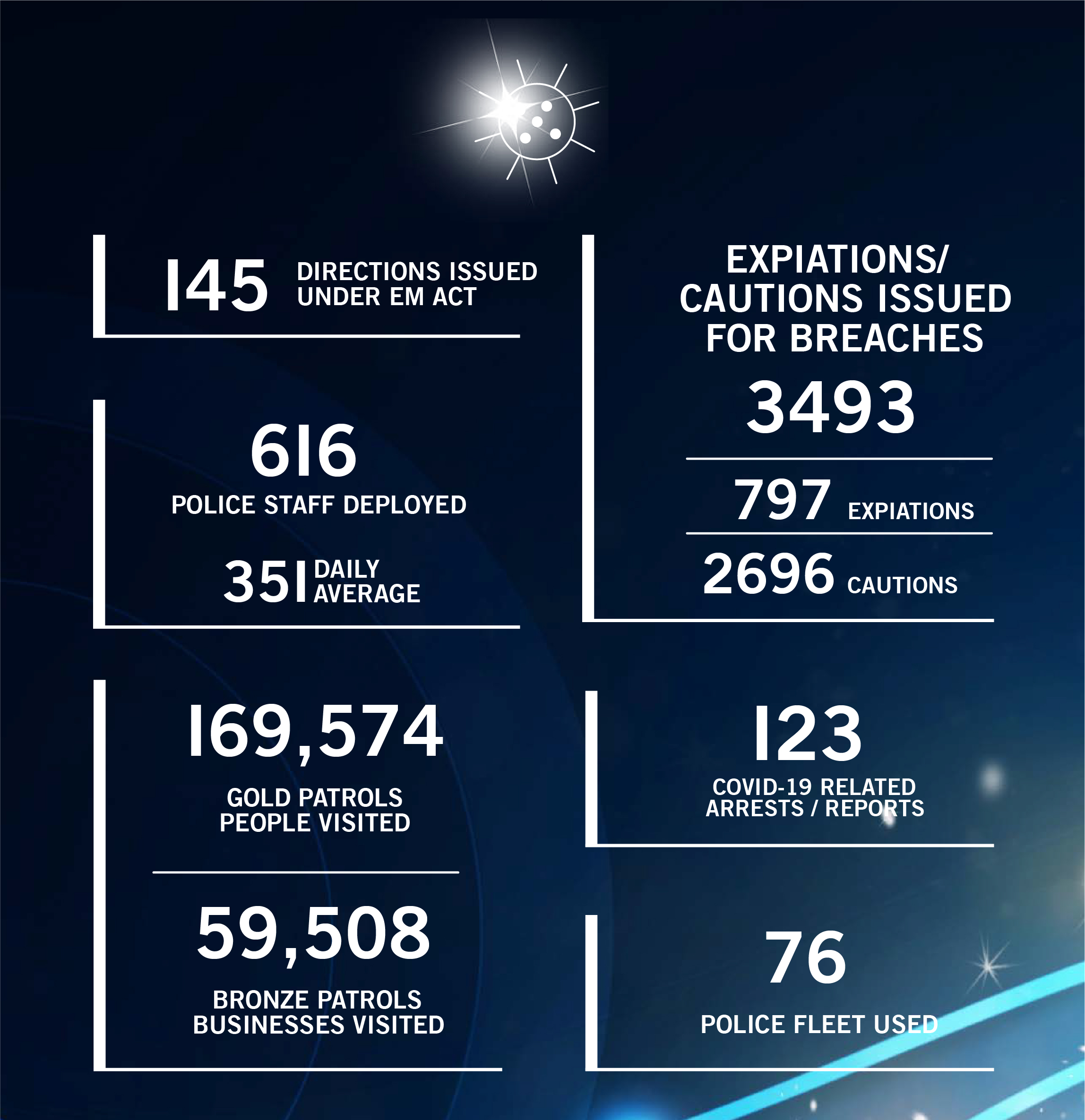
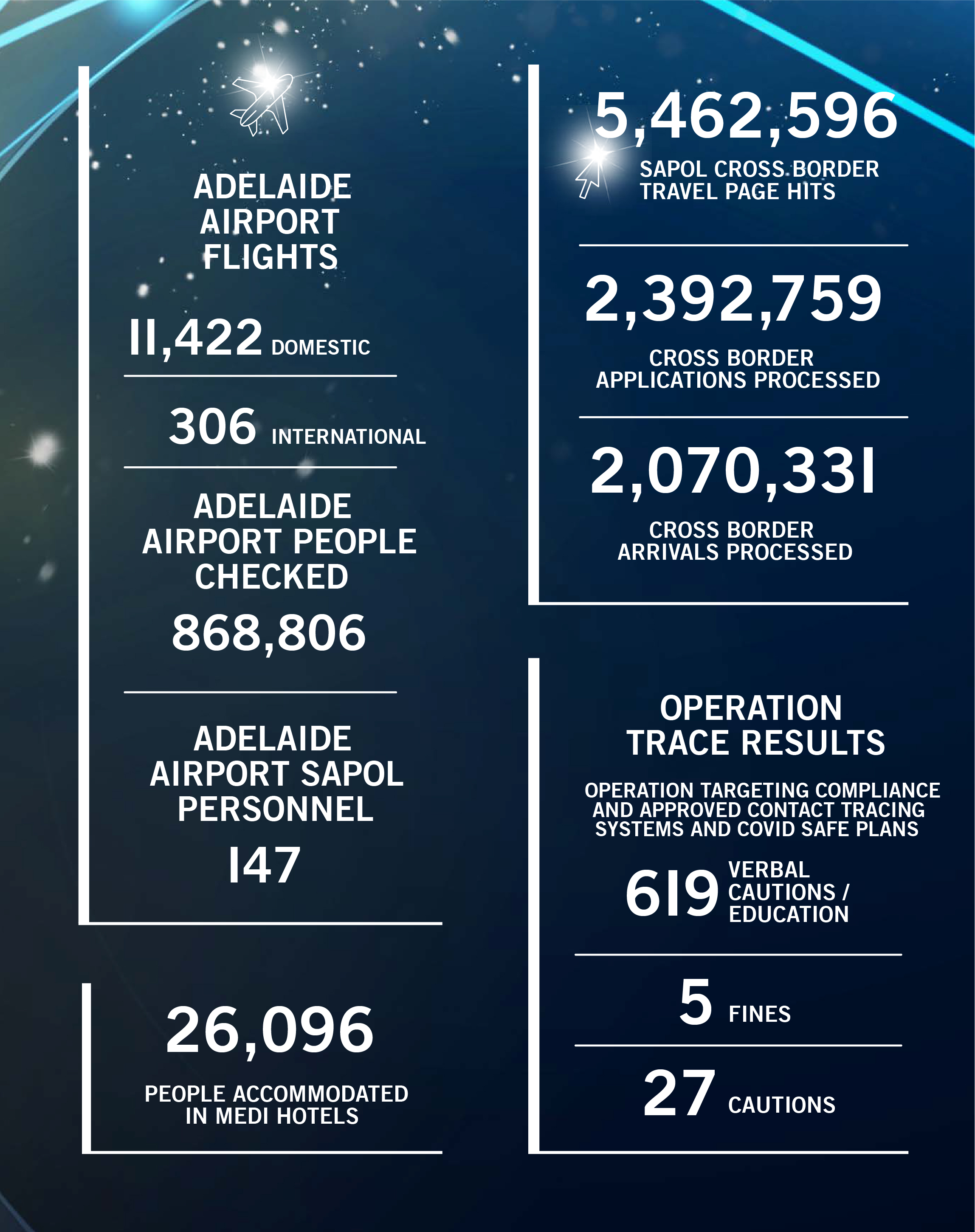
Agency contribution to whole of Government objectives
Key objective | Agency’s contribution |
|---|---|
Lower costs | Introduction of Electric Vehicles
|
Better Services | Counter Terrorism
Protecting our police
Advanced Mobile Location Services (AML)
|
Agency specific objectives and performance
Agency objectives | Indicators | Performance |
|---|---|---|
Public Safety | Level of Community Confidence in policing services. Percentage of Grade 1 tasking’s in the metropolitan area responded within 15 minutes. Number of calls received by Call Centre. Number of 000 calls presented to Police Communications Centre by Telstra. | 84.4% 93.2%, above the target of ≥80.0% 583 253 186 329 |
Crime and Criminal Justice Services | Number of recorded offences against the person as reported by/on behalf of victims per 1000 head of population. Number of recorded offences against property as reported by/on behalf of victims per 1000 head of population. | 12.80 above projection of ≤12.22 45.20 below projection of ≤53.32 |
Road Safety | Number of Road Safety Contacts issued personally involving unique expiation notices and apprehension reports/incident reports excluding camera. Number of driver screening tests conducted.* Number of SAPOL Road Safety Centre attendees, children and young adults (16-24 years).* Total number of people attending SAPOL road safety programs.* | 169 492 495 393, below the target of 500 000 117 25 925 |
* Some results reflect the impact of COVID-19 on activities.
Corporate performance summary
Crime Trends
Over the 10 year period from financial year 2011-12 to 2020-21 there has been a steady reduction in overall recorded crime resulting in a decrease of 11.9% or 13 925 offences (116 639 to 102 714) for total offences against person and property.
In summary, from 2019-20 to 2020-21, there was a decrease in overall recorded crime of 12.1% or 14 125 offences (116 839 to 102 714).
Total Offences Against Person and Property
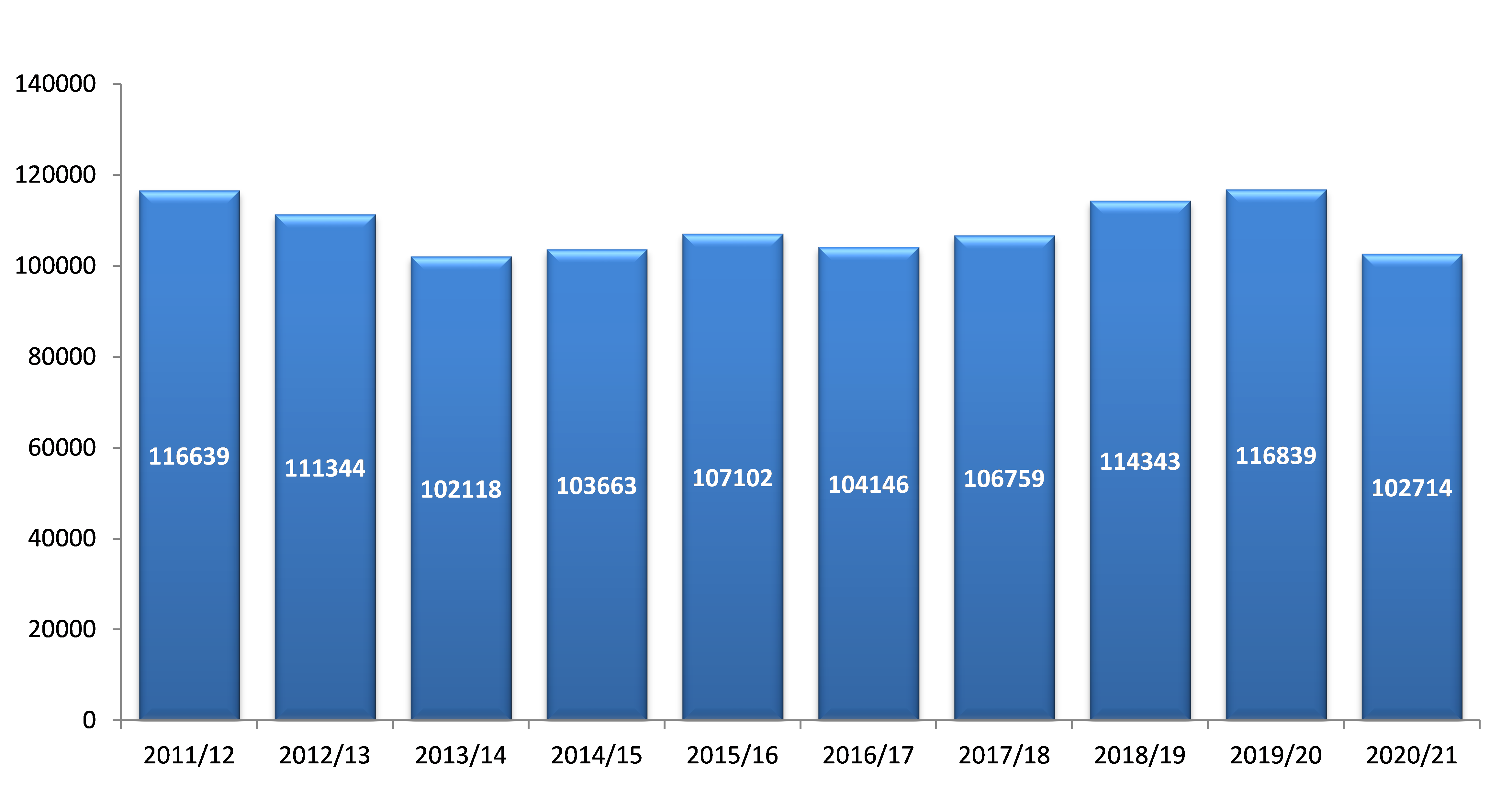
Note: to align with SAPOL’s regular monthly crime data reporting the previously published 2019-20 data has been refreshed.
Offence counts and groupings are in line with the Australian Bureau of Statistics (ABS) Australian and New Zealand Standard Offence Classification (ANZSOC).
Crime statistics are published online at https://www.police.sa.gov.au each month.
Total Offences Against the Person
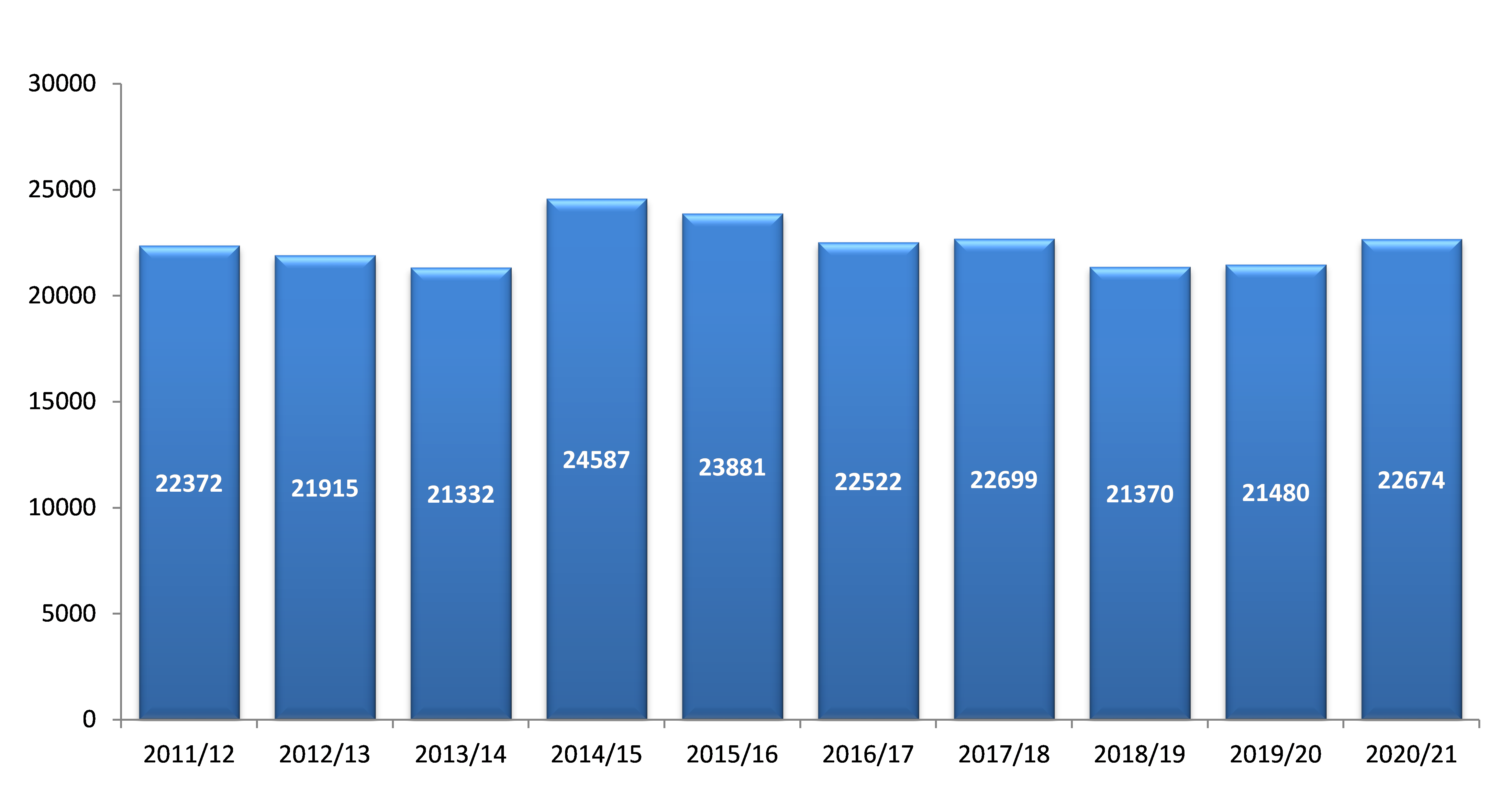
OFFENCES AGAINST THE PERSON | Financial Year | ||
|---|---|---|---|
2019-20 | 2020-21 | Change | |
Homicide and Related Offences | 38 | 36 | -5.3% |
Acts Intended to Cause Injury | 17 121 | 18 561 | 8.4% |
Sexual Assault and Related Offences | 2 024 | 2 145 | 6.0% |
Robbery and Related Offences | 655 | 522 | -20.3% |
Other Offences Against the Person | 1 642 | 1 410 | -14.1% |
TOTAL OFFENCES AGAINST THE PERSON | 21 480 | 22 674 | 5.6% |
Family & Domestic Abuse-Related | 8 925 | 9 760 | 9.4% |
Homicide and Related Offences decreased by 5.3% (2 offences).
Acts Intended to Cause Injury increased by 8.4% (1 440 offences). Within this category, Serious Assault not Resulting in Injury increased 16.6% (1 583 offences).
Sexual Assault and Related Offences increased by 6.0% (121 offences). Within this category, Aggravated Sexual Assault increased by 9.5% (110 offences), Non-Aggravated Sexual Assault increased by 6.7% (30 offences) and Non-Assaultive Sexual Offences decreased by 4.5% (19 offences).
Robbery and Related Offences decreased by 20.3% (133 offences), with Aggravated Robbery Offences decreasing by 24.0% (113 offences).
Total Offences Against Property
OFFENCES AGAINST PROPERTY | Financial Year | ||
|---|---|---|---|
2019-20 | 2020-21 | Change | |
Serious Criminal Trespass | 15 532 | 12 066 | -22.3% |
Theft and Related Offences | 53 872 | 43 064 | -20.1% |
Fraud, Deception and Related Offences | 4 073 | 4 629 | 13.7% |
Property Damage and Environmental | 21 882 | 20 281 | -7.3% |
TOTAL OFFENCES AGAINST PROPERTY | 95 359 | 80 040 | -16.1% |
Family & Domestic Abuse-Related | 3 147 | 3 165 | 0.6% |
Serious Criminal Trespass Offences decreased by 22.3% (3 466 offences). Within this category SCT-Residence decreased by 23.7% (1 697 offences) and SCT-Non Residence decreased by 21.6% (1 027 offences).
Theft and Related Offences decreased by 20.1% (10 808 offences). The main contributor in this category is Other Theft which decreased by 23.0% (5 909 offences). These offences predominantly include Dishonestly Take Property without Consent and Fuel Theft.
Fraud, Deception and Related Offences increased by 13.7% (556 offences). Within this category, Obtain Benefit by Deception increased by 20.0% (588 offences).
Property Damage and Environmental Offences decreased by 7.3% (1 601 offences). The sub-categories of Property Damage by fire or explosion decreased by 20.0% (244 offences) and Other Property Damage and Environmental decreased by 7.1% (1 364 offences). Environmental relates to the natural world and the impact of human activity e.g. environmental noise.
Total Offences Against Good Order
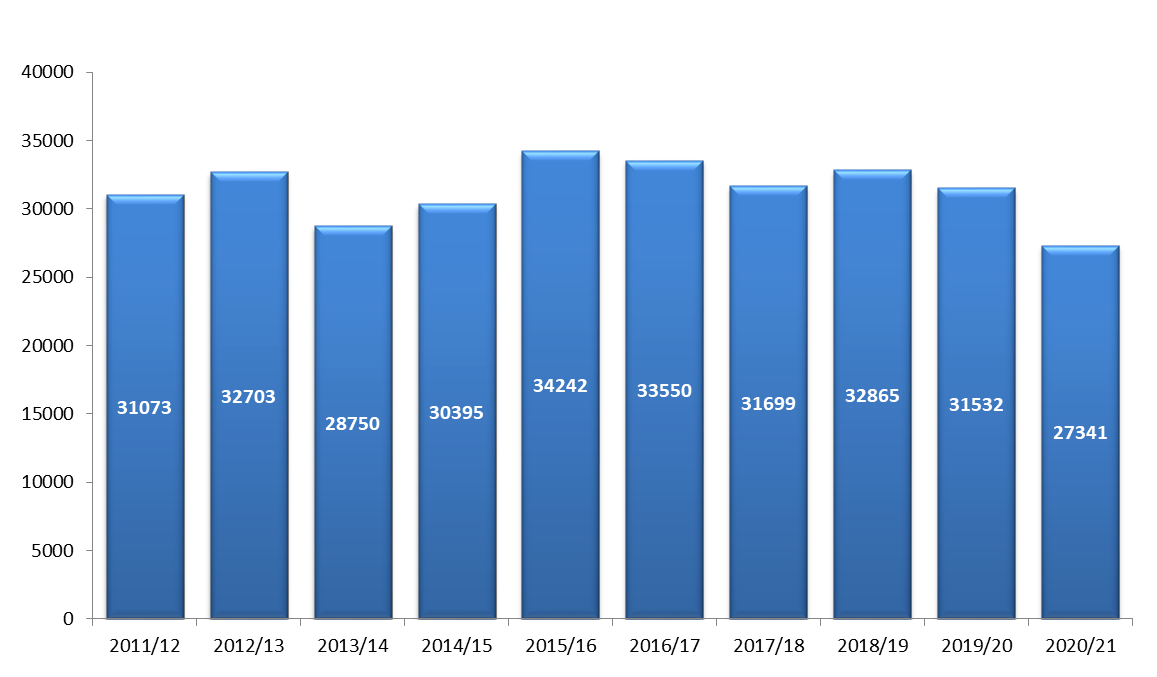
OFFENCES AGAINST GOOD ORDER | Financial Year | ||
|---|---|---|---|
2019-20 | 2020-21 | Change | |
Illicit Drug Offences | 5 664 | 3 874 | -31.6% |
Weapons/Explosives Offences | 3 060 | 2 450 | -19.9% |
Public Order Offences | 4 302 | 3 991 | -7.2% |
Justice Procedure Offences | 17 164 | 16 008 | -6.7% |
Other Miscellaneous Offences | 1 342 | 1 018 | -24.1% |
TOTAL OFFENCES AGAINST GOOD ORDER | 31 532 | 27 341 | -13.3% |
Illicit Drug Offences decreased by 31.6% (1 790 offences). The main contributor is Possess/Use Drug Offences which decreased by 40.8% (1 060 offences).
Weapons/Explosives Offences decreased by 19.9% (610 offences). The main contributor is Regulated Weapons/Explosives Offences which decreased by 20.4% (408 offences).
Public Order Offences decreased by 7.2% (311 offences). Within this category, Trespass decreased by 26.6% (159 offences) and Criminal Intent decreased by 27.8% (153 offences).
Justice Procedure Offences decreased by 6.7% (1 156 offences). This category includes Breach of Bail which decreased by 10.8% (1 112 offences).
Total General Expiations, Cannabis Expiations and Drug Diversions
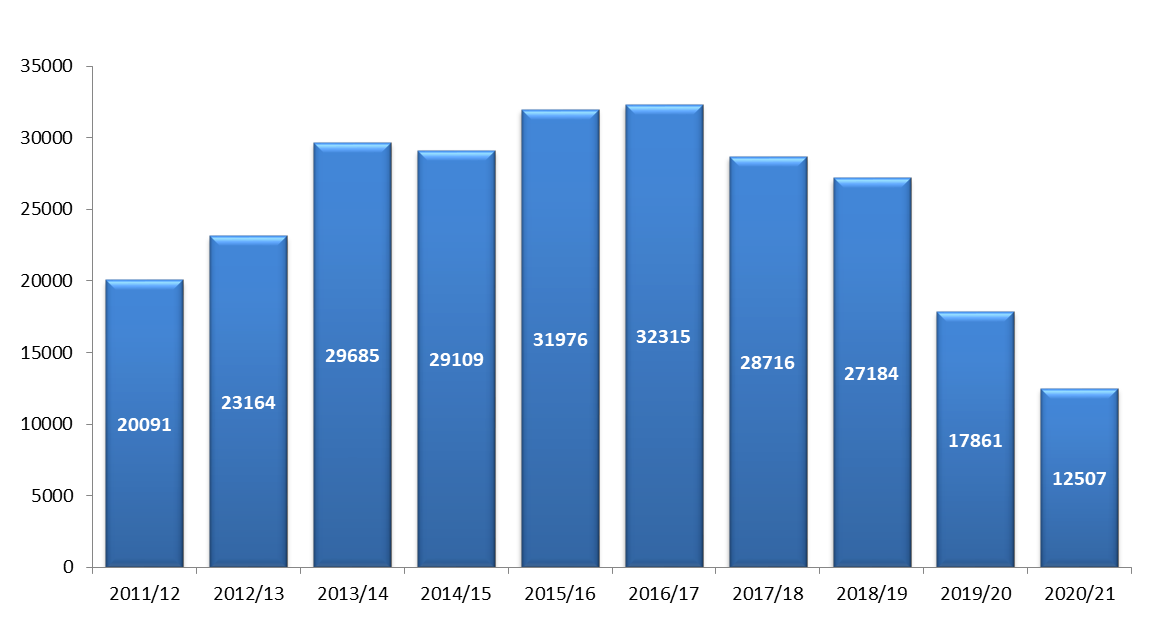
GENERAL EXPIATION OFFENCES | Financial Year | ||
|---|---|---|---|
2019-20 | 2020-21 | Change | |
Other Theft (GENs) | 2 187 | 335 | -84.7% |
Other Property Damage and Environmental (GENs) | 5 | 11 | 120.0% |
Cannabis Expiation Notices (CENs) | 6 734 | 5 251 | -22.0% |
Drug Diversions | 3 501 | 2 335 | -33.3% |
Other Weapons / Explosives Offences (GENs) | 103 | 102 | -1.0% |
Other Public Order Offences (GENs) | 4 506 | 3 721 | -17.4% |
Other Justice Procedure Offences (GENs) | 91 | 88 | -3.3% |
Other Miscellaneous Offences (GENs) | 734 | 664 | -9.5% |
TOTAL GENERAL EXPIATION OFFENCES | 17 861 | 12 507 | -30.0% |
Total General Expiations have decreased by 30.0% (5 354 GENs). Cannabis Expiation Notices (CENs) decreased by 22.0% (1 483 CENs) and Drug Diversions decreased by 33.3% (1 166 Diversions). This is due to the Illicit Drug Diversion Initiative implementing changes which took effect on 1 April 2019. An adult can only be referred to the Drug Diversion Program no more than twice in a four year period, on the third detection the adult is referred directly to court.
Employment opportunity programs
Program name | Performance |
|---|---|
Aboriginal Employment Register (AER) | SAPOL is committed to assist in increasing the employment of Aboriginal people in the South Australian public sector. This includes connecting Aboriginal job seekers to employment opportunities in SAPOL and providing mentoring support and leadership development opportunities for young Aboriginal people. In the last financial year, SAPOL continues to mentor and support its Aboriginal trainees. As part of their traineeship, trainees are undertaking their studies in Certificate III in Community Services whilst they are being mentored in SAPOL to provide them guidance and support. SAPOL mentors and staff assists to develop trainees’ skills in the workplace, develop their understanding of government, as well as set and achieve professional/career goals. SAPOL values the contribution and cultural diversity that Aboriginal people bring to the public sector workforce. Accordingly, SAPOL continues to consider Aboriginal people in the AER when filling vacancies in order to help them with their career and offer professional and development opportunities. |
Agency performance management and development systems
Performance management and development system | Performance |
|---|---|
Individual Performance Management | SAPOL’s online Individual Performance Management and Development system (iEngage performance and development) runs over a 12 monthly cycle with a mid-term review 6 monthly before completing and recommencing. iEngage is focused on promoting a meaningful and purposeful feedback framework between employees and supervisors that will ensure ongoing development of the individual whilst incorporating wellbeing, performance improvement and workplace behaviour expectations. Underpinning this approach is the expectation of regular performance and development discussions between supervisors and employees. The system has two primary elements:
SAPOL experienced a reduction in completion of iEngage in the reporting period of 2020-21 as a result of significant redirection of personnel to alternate COVID-19 duties, impacting on the normal administrative arrangements for supervisors and managers. |
Work health, safety and return to work programs
Program name | Performance |
|---|---|
Work health, safety and rehabilitation programs | SAPOL’s Preventions Section works closely with Employee Assistance and Injury Management sections with a shared goal of providing a safe and supportive workplace. The Commissioner’s Occupational Health Safety and Welfare Advisory Committee, SAPOL’s principal consultative committee involving both management and industrial association officials, continues to monitor, review and provide guidance on safety performance and issues which impact on the health, safety and welfare of employees. The Hazard and Incident reporting System recorded 359 hazards, 1121 incidents (with injury) and 1286 incidents (no injury). COVID-19 impacted all aspects of the agency with a continued focus on safe work practices and wellbeing assistance. Continuation of the COVID-19 employee hotline provided assistance and timely advice to staff. |
Early Intervention | The Early Intervention Program (EIP) aims to assist employees who believe they have suffered a work related injury or illness and who require some treatment, but have not lost any time from work. Injured employees are referred for suitable medical assessment, evaluation, treatment, and rehabilitation services to enable the best practicable levels of physical and/or mental recovery. Injured employees are advised on the options available to them in respect to the early intervention program or lodging a workers compensation claim. During 2020-21:
|
Employee Assistance | The Employee Assistance Program (EAP) is an external professional counselling service delivered by mental health professionals, offering support for work-related and personal problems provided by Corporate Health Group. The EAP is a confidential service available to all employees and immediate family members who can access up to six sessions every two years. During 2020-21, the EAP resulted in 299 initial consultations and a total of 740 consultations. |
Reconditioning Program and Preferred Health Service Providers List | SAPOL implemented a range of health and wellbeing initiatives designed to promote healthy living and improve the overall health of the workforce by delivering evidenced based education/advice, providing health and fitness equipment and offering support to those in need. The Reconditioning Program links staff with appropriate allied health service providers and helps by covering any out of pocket expenses. The program is open to all employees wishing to improve their physical health and excludes work related injuries. Between 1 October 2020 to 30 June 2021, 177 employees registered and 902 consultations occurred. This program was trialled in the previous financial year and provided significant improvements in participants’ health. Supporting the Reconditioning Program is SAPOL’s ‘Preferred Health Service Providers List’ which currently has 241 allied health practitioners participating in the program. A total of 53 new applications were received during 2020-21. This list allows SAPOL to communicate with treating allied health professionals regarding the unique nature of policing and better inform our workforce of service providers that best suit their needs. Services are provided by dieticians, physiotherapists, exercise physiologists, podiatrists and sleep clinicians. |
Operation Nutrition Support | Operational Nutrition Support is an online nutrition program designed for SAPOL by accredited dietitians from Sprout Nutrition. The program aims to teach nutrition basics such as reading food labels, portion control, healthy eating as well as addressing how food influences sleep, energy levels and mood. The topics are specifically designed for shift workers but are broad enough to benefit the broader workforce. SAPOL has had over 400 employees register and continue to use this online learning program. |
| Body Scan Program | SAPOL has purchased an InBody 570 unit which measures and analyses an individual’s body composition in terms of water, fat, protein, muscle and bone mineral. The device can determine the weight and percentage of lean muscle mass and body fat in segmented body parts. Results are used to springboard participants into physical health improvement programs such as the Reconditioning Program mentioned above. Purchased in May 2021 and as at 30 June 2021, SAPOL conducted 52 body scans. |
Workplace injury claims | Current year 2020-21 | Past year 2019-21 | % Change |
|---|---|---|---|
Total new workplace injury claims* | 363 | 354 | +2.5% |
Fatalities | 0 | 0 | 0% |
Seriously injured workers** | 0 | 4 | -100.0% |
Significant injuries (where lost time exceeds a working week, expressed as frequency rate per 1000 FTE) | 17.07 | 24.29 | -29.7% |
Data extract run 1/7/2021
* excludes additional compensation claims
** number of claimants assessed during the reporting period as having a whole person impairment of 30% or more under the Return to Work Act 2014
(Part 2 Division 5).
Work health and safety regulations | Current year 2020-21 | Past year 2019-20 | % Change (+ / -) |
|---|---|---|---|
Number of notifiable incidents (Work Health and Safety Act 2012, Part 3) | 5 | 5 | 0% |
Number of provisional improvement, improvement and prohibition notices (Work Health and Safety Act 2012 Sections 90, 191 and 195) | 1 | 1 | 0% |
Return to work costs* | Current year 2020-21 | Past year 2019-20 | % Change |
|---|---|---|---|
Total gross workers compensation expenditure ($) | $23 521 763 | $17 788 692 | +32.2% |
Income support payments – gross ($) | $14 706 691 | $10 212 314 | +44.0% |
* Based on twelve months of data before third party recovery.
Data for previous years is available at:
https://data.sa.gov.au/data/dataset/annual-reporting-data
Executive employment in the agency
Executive classification | Number of executives |
|---|---|
Commissioner | 1 |
Deputy Commissioner | 1 |
Assistant Commissioners* | 8 |
SA Executive Service Level 2 | 4 |
SA Executive Service Level 1 | 4 |
* Includes one Assistant Commissioner on long- term leave.
Data for previous years is available at:
https://data.sa.gov.au/data/dataset/annual-reporting-data
The Office of the Commissioner for Public Sector Employment has a workforce information page that provides further information on the breakdown of executive gender, salary and tenure by agency.
Previous page - Overview: about the agency and Next page - Financial performance
